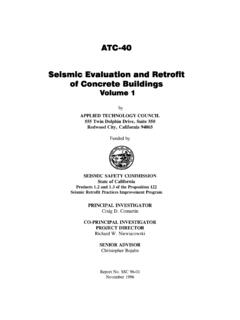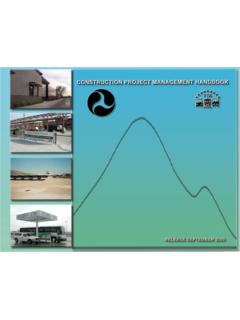Transcription of Fence - USDA
1 Fence Woven Wire Conservation Practice Job Sheet RI- 382(b) Definition A constructed barrier to livestock, wildlife or people. Purpose This job sheet is provided as a component of a resource conservation plan. This practice may be applied to contain and control livestock and wildlife movement, facilitate a prescribed grazing system, protect sensitive areas from grazing livestock, and to eliminate access to unsafe areas. Conditions where practice applies This practice may be used on any area where a Fence is needed to control access, movement and containment of livestock and wildlife and where people safety and movement is of concern. This job sheet is provided as a component of a resource conservation plan. Conservation plan maps showing the approximate Fence location, complementary conservation practices, grazing schedule, other relevant information, and additional specifications may be included.
2 General Criteria and Specifications All Fence construction shall comply with federal, state, and local fencing codes. Practice Lifespan is 20 years. Fence line clearing Fence lines will be cleared of brush and trees; gullies and steep banks may require grading. Clearing along stream banks will be held to a minimum and no vegetation may be removed within the buffer area, except as required for stream crossings. Fencing materials shall be of a quality and durability that meets the intended management objectives. construction shall be performed in a manner that meets the intended management objective. Wire and hardware will be new, galvanized material. Line post Maximum spacing between posts is feet. All wooden line posts shall be set at least 30 inches into the ground. Suitable line posts 3 in diameter wooden posts of black locust, red cedar (mostly heartwood), redwood , and pressure treated pine or other wood of equal life and strength. Pressure treatment shall meet the requirements for ground contact.
3 Job Sheet Fence (Woven Wire) (382b)Page 1 of 12 January 2010 Steel posts must be new and be painted or galvanized and weigh a minimum of pounds per one foot of length. Post will be driven 18 inches in the ground or as specified by manufacturer. Every 50 feet or 4th post will be wooden. The following steel posts are acceptable for line posts: Style 1 T Section 1- 3/8 x 1-3/8 x 1/8 thick Style 2 U Section 2 x 1-1/4 x 3/32 Style 3 L Section 2 x 2 x Lightweight stamped-steel posts are not allowed. Brace post: Posts shall be set and maintained in a vertical position. All wooden brace posts are to be 5 minimum diameter and set 3 feet into the ground. Horizontal rail brace posts are to be 4 minimum diameter by 8 ft. long and be installed 8 12 below the top of the vertical brace post. Corners and braces: Refer to drawings on pages 7-9 for Fence brace configurations and spacing.
4 Single H Braces: Single H Brace corners and end braces may only be installed at the ends of straight Fence spans of 165 feet or less. Double H Braces: All corners, Fence line ends and gate openings require Double H Brace assemblies, except that Single H Braces may be substituted in straight Fence spans of 165 feet or less. Double H Brace Pull Assemblies: Double H Brace pull assemblies are required in straight Fence spans at a maximum spacing of 660 feet. Brace wire shall be high tensile, galvanized steel, or 9 gauge soft wire. Adjoining Fences: A Fence adjoining an existing Fence must terminate in a brace assembly as required above. Corners: A bend in the Fence tighter than 20 degrees is considered a corner and not a straight pull brace. (In an 8-foot long brace section, 20 degrees is approx. 3 feet off the straight line. Refer to drawings). The above H brace rules apply to corners considering each wire-pull direction from the corner post. Combination single and double H corners are permitted.
5 If hand set, all backfilled material shall be thoroughly tamped in 4 layers. Post holes shall be at least 6 larger than the diameter or side dimension of the posts. Synthetic posts are to be installed as specified by the manufacturer. If concrete backfill is used, the concrete must be pre-mixed, and worked into place up to the ground surface. No stress shall be applied to posts set in concrete for at least 24 hours after the concrete has set. Wire Wire shall have a minimum Class 3 zinc coating and shall meet the requirements of ASTM A116 or Class I zinc coating with ounces of zinc per ft2 meeting the requirements of ASTM A116. For Cattle, fencing shall be 1047 woven wire, which has 10 line wires, with stays (the vertical wires) on 9 spacing. Top and Bottom line wires shall be at least 10 gauge (medium weight) and the filler wires (the remainder of the Fence wires) will be a minimum of 12 gauge. Job Sheet Fence (Woven Wire) (382b)Page 2 of 12 January 2010 For Horses, use square knot mesh which has 2 horizontal by 4 vertical openings, or V-mesh (diamond mesh) style horse fencing with triangular openings 2 wide by 4 tall.
6 The mesh must be fastened by wire wrapping with no sharp wire ends. Horse fences should be 47 to 50 high. Horizontal wires must be12 gauge steel, or 14 gauge high tensile. Vertical wires are to be at least 14 gauge steel. For other Animals, a mesh and Fence height that is appropriate to the species as recommended by the manufacturer. High tensile woven wire 12 gauge may be used for all animals as specified by manufacturer. Welded mesh is prone to failure, and therefore is not recommended or allowed. Fence top Deterrent Barbed wire: At least one strand of barbed wire is to be placed no m ore than 6 above the woven wire. Additional strands may be added above the first at the same spacing. The barbed wire shall consist of 2 strands of wire with class 3 galvanized 4-point barbs spaced not more than 5 apart. Galvanized barbed wire shall be fabricated from 12 gauge class 1 galvanized or high tensile class 3 barbed 15 gauge galvanized strand wire or meeting the requirements of ASTM A121.
7 Barbed wire should not be electrified. Electrified Wire: In lieu of barbed wire, the same number of 12 gauge galvanized wires may be installed electrified on the spacing needed for barbed wire. The wire must be mounted and energized as required by the high tensile electric Fence job sheet. Electric and barbed wire Fence top deterrents may not be combined. Wood Rail: A wood top rail may be installed no more than 6 above the woven wire to strengthen the Fence in lieu of top wires, or a single electric wire with stand-off insulators may be included. The fencing may be stapled to the rail for added stiffness. With top rails, no post bracing assemblies are needed, but gate posts must be 5 in diameter and be set 3 feet in the ground. Wire placement Fencing and top deterrent (barb wire) should be installed according to Figure 3. Stretching wire Woven wire shall be stretched tight with no sags or waves in the material when viewed along the Fence line. Wire at the end posts and corner posts shall be wrapped and attached to itself with 3 twists.
8 For barbed wire at the Fence top, pull taut. A stretch of 100 feet (prior to attachment to posts) should sag no more than in the middle 4 in warm weather and not more than 2 in cold weather. Attaching fencing to post The fencing wire shall be placed on the livestock side of line posts and on the outside of corners and posts in bends and braces in bends. Woven wire fencing shall be attached to post on alternate horizontal strands as a minimum. Each strand of barbed wire used shall be attached to each post using a 9-gauge galvanized 1 staple driven diagonally with the grain of the wood and at a slight downward angle (except in dips). Staples shall be driven tight to the post. Fasten fencing to steel line post with either two turns of 14 gauge galvanized steel wire or the post manufacturer s special wire clips. Job Sheet Fence (Woven Wire) (382b)Page 3 of 12 January 2010 Wire shall be spliced with a figure-eight knot, or twisted with 8 wraps of each end about the other (western union splice), or by suitable splice sleeves applied with a tool designed for the purpose.
9 Other Considerations Fences across gullies or streams require special braces and design. Breakaway fences or swinging water gaps allow debris and water to flow past the Fence line without destroying the adjacent Fence . Any permanent fencing for grazing livestock should allow flexibility to facilitate implementation of the grazing plan and permit land management activities such as nutrient application, pest control, forage harvest, and other appropriate practices. Follow all manufacturers safety precautions for handling and installing fencing materials. Locate fences to facilitate maintenance. Where applicable, clear right of ways should be established and maintained to facilitate Fence construction and maintenance. When possible, install fences across slopes to improve grazing distribution, rainfall infiltration, and reduce soil erosion. Locate fences to facilitate livestock management, handling, watering, and feeding. Consider placing permanent riparian stream fencing at the edge of the protected buffer or at least 2 times the active channel width from the top of the stream bank but never less than 10 feet.
10 It is recommended that the stream Fence have a maintenance gate installed. Woven wire fencing is not recommended for use in riparian areas due to flooding damage. Approved alternative Fence systems include Common Sense Fence or equivalent. Other fencing systems may be approved by an NRCS Resource Conservationist (RC), and installed to manufacturer s recommendation as approved by NRCS Resource Conservationist (RC). Alternative fencing and bracing systems: Alternative fencing and bracing systems must be pre-approved by an NRCS Resource Conservationist (RC), and must be installed according to manufacturer s recommendations as approved by NRCS Resource Conservationist (RC). Job Sheet Fence (Woven Wire) (382b)Page 4 of 12 January 2010 Specifications Worksheet Site-specific requirements are listed on the specifications sheet. Additional provisions may be contained in the conservation plan or other acceptable form of documentation. Specifications are prepared in accordance with the NRCS Field Office Technical Guide.














